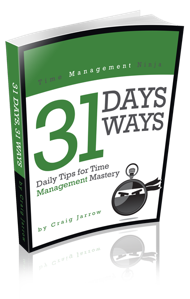
Confession time. I’m an email addict.
Or rather I was. Recognizing I had a problem was the first step toward a resolution and a happier relationship with my inbox.
In a typical day, I would be distracted by email more than 40 times! Many “checks” wouldn’t last more than a few seconds but could still derail my train of thought and momentum on other tasks.
If I could reduce those distractions, I felt like I could be more productive and creative in my work.
So I embarked on a mission to dramatically cut back on email.
Here are the steps I took.
1. Elimination
The initial step was to eliminate the unnecessary messages from hitting my inbox in the first place. Over the course of a month, I ruthlessly unsubscribed from newsletters and commercial mailing lists I’d signed up for over the years.
Even if you bought something from some online store one time, you might find yourself on their mailing list forever. As a marketer, I understand the value of email as an advertising medium, but as a consumer there comes a time to reduce the distractions and “noise” in your life.
One tool you can use to help with the Elimination stage is unroll.me, which will show you all the lists you are subscribed to and help you mass-unsubscribe. They also will generate “roll-up” emails that combine several messages into one digest. I haven’t used that feature but it might be worthwhile to check out as well.
2. Filtering
After unsubscribing, I set up a number of filters in Gmail (hands down one of the best features of the interface!). For example, I set up filters for all Groupon and Living Social emails to “skip the inbox” and go directly to a “Daily Deals” folder.
Today I have more than 50 filters enabled. These are for messages that I wasn’t quite ready to cut off completely but didn’t require immediate attention.
This has reduced the number of messages that hit my inbox by at least 25%.
3. Batch Processing
One of my biggest contributors to checking email 40+ times a day was the habit of leaving the Gmail tab open in my browser all day long.
As this was a 8+ year habit, it was not easy to kick, so I began by taking baby steps.
First I would only check every half hour. It was like a little reward for doing a half-hour’s worth of uninterrupted work. Then I moved to an hour, and finally every two hours.
In the 4-Hour Workweek, Tim Ferriss recommends just checking email 2x a day and setting up auto-replies to let senders know about your system. For me, that was a little extreme because some of my messages still required more timely responses.
But regardless, logging in only every 1-2 hours can reduce your email addiction by leaps and bounds. I went from 40+ checks a day to less than 10. Plus, I’ve found it more efficient to process incoming messages in larger “chunks,” rather than one at a time.
Other experts say to stay out of your inbox for the first part of you day. There’s even a book about it called Never Check Email in the Morning. I don’t follow this rule. I like to see if there are any urgent messages that need immediate action and start the day with a clean slate.
4. One Touch
The other element of batch processing is sticking to a “one-touch” system. Similar to David Allen’s Getting Things Done method, I try and deal with each message only once.
Ari Meisel of LessDoing.com recommends a 3-pronged attack: Delete, Deal, or Delegate.
If an email requires more than follow-up or a longer thought process, I write it down in a separate task list so it’s not cluttering my inbox.
5. Outsourcing
The final step is Outsourcing. I recommend this only for high-volume inboxes, but extra efficiency can be gained by adding a virtual assistant as an extra human filtering layer.
They can declutter the unimportant messages that slipped through your filters (and create new filters for those in the future), as well as reply to simple messages on your behalf.
By delegating your inbox duties you’re left with only the messages you truly need to see and address.
Wrapping Up
In terms of my email addiction, I can’t say I’m 100% “clean,” but I’m much better off than the junkie I used to be.
What tactics have worked for you?
 I am the author of Time Management Ninja and help individuals and companies reclaim their time to be more productive. As well, I am the author of the book
I am the author of Time Management Ninja and help individuals and companies reclaim their time to be more productive. As well, I am the author of the book 

There are a number of things people can do and tools available for helping reduce the email addiction responses we’ve all developed. Here are a couple I give my time management audiences regularly:
1. Turn Off New Email Alerts. The “ding” and “flash” of new email alerts trigger the human startle response. Once triggered we’re virtually certain to do something about it – check the inbox. This causes huge distraction and can be easily remedied by turning off these functions. Then, just check your inbox regularly throughout the day – what “regular” means that day.
2. For Outlook users, RepriseMail – http://www.reprisemail.com – is a great analytics tool to see how and where you use email. It’s a free plugin and delivers a weekly report that details your usage, along with executive-style tips and tricks for making better use of email.
3. For a general filtering tool, check out Sanebox – http://www.sanebox.com. It’s also free and the service filters your email, then delivers you a digested version each day.
If you’d like a true time management methodology that focuses on how to use email better, plus just get more done each day, check out my book “QuietSpacing – 2nd Edition” at Amazon.
Hope those suggestions help!
PHB
Thanks Paul, great suggestions! The alerts are focus-killers for sure — the Outlook popup, the phone vibration, the so-and-so is now online Skype notifications… all bad news for the task at hand.
Hadn’t heard of sanebox, will definitely check it out!
Sanebox is one my favorites.
It keeps my email to a minimum so much that it’s scary sometimes.
PS – see the sidebar… Sanebox is there. 😉
Outsource your e-mail? Are you mad? Let me list it: privacy, corporate secrets, personal location at any time, putting “for your eyes only”-mail public, security none existent…..the fact that you even suggest it drives shivers down my spine. I can see that if you are top dog and have a secretary who could do it…but paid outsourcing to an external moderator is silly, non-responsible and damn straight out stupid. :-/
Thanks Paul, great suggestions! The alerts are focus-killers for sure — the Outlook popup, the phone vibration, the so-and-so is now online Skype notifications… all bad news for the task at hand. Good work, Keep it up.